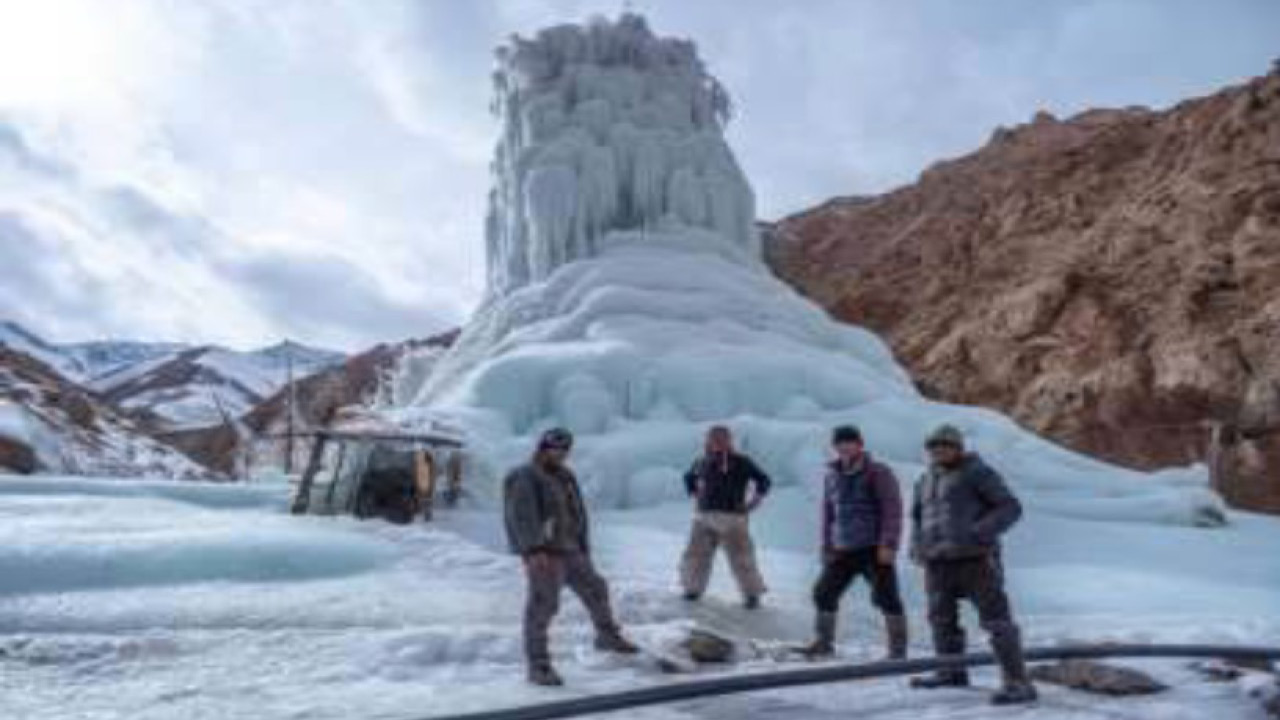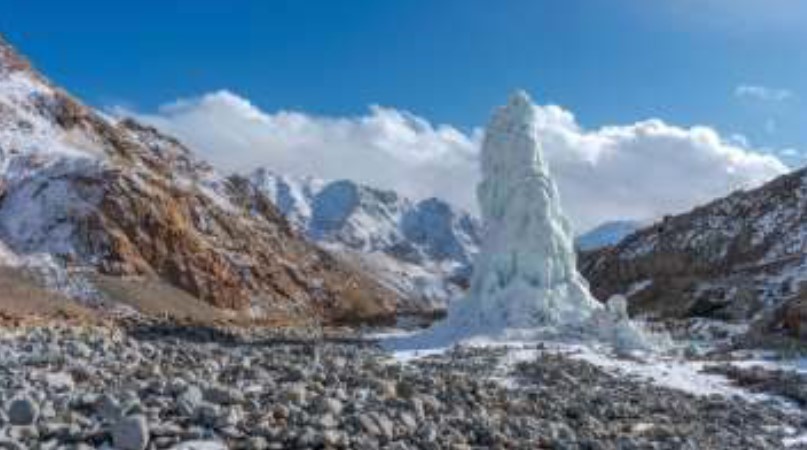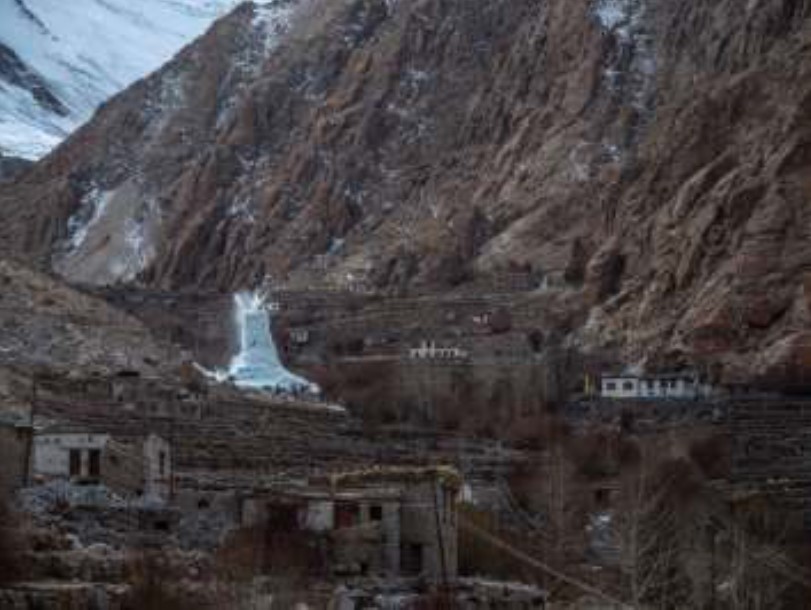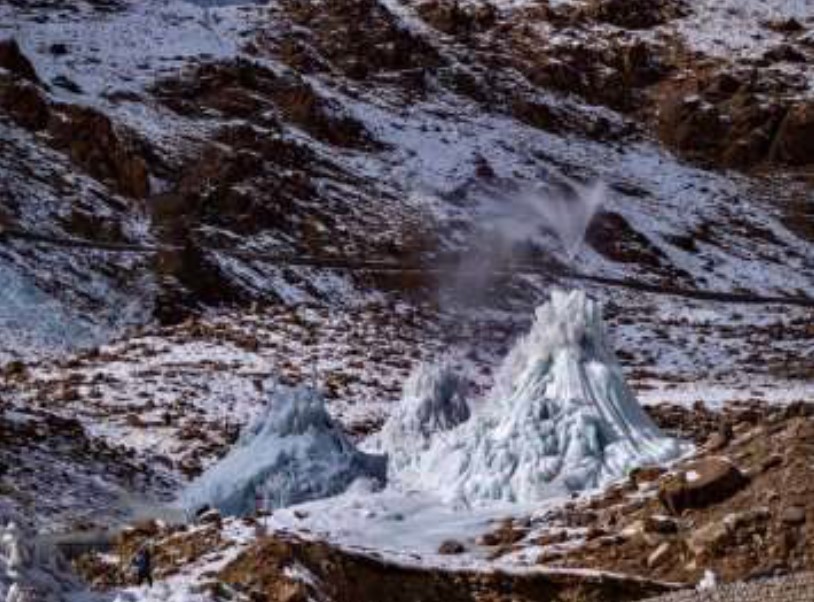Reviving Ladakh’s Abandoned Hamlets through Ice-Stupa Innovation and Tribal Resilience

Reviving Ladakh’s Abandoned Hamlets through Ice-Stupa Innovation and Tribal Resilience
Problem
- The problem of water scarcity is threatening the way of life in Ladakh
- Villages in the region face an acute water shortage in the months of April and May
- By mid-June, there is an excess of water due to fast snow-melting
- Flash floods car caused due to snow melting
- Post-September, the stream flows continuously but it is not utilised because all farming activities cease by September
Solution
- Water is piped from 60m upstream and it rises close to 60m up from the ground when it reaches the village
- Then it is made to fall from that height on cold Ladakhi winter nights when it is -30 to -50°C outside
- The water freezes by the time it reaches the ground and slowly forms a huge cone or Ice Stupa
- When the Ice Stupa melts, it feeds the fields until the real glacial meltwaters start flowing in June
Outcomes
- At one location in Phyang, the Ice Stupa has enabled the villagers to plant and grow 5,000 poplar trees
- At other locations, the water has helped to increase the average yearly crop yield
- Ice Stupas have also boosted winter eco-tourism in the region and enabled locals to look into diverse livelihood activities
- Ice Stupas have helped to create a specific engineering capacity within the Ladakhi population, which is enabling them to address the emerging water crisis in the region
Project Details
Category: Environment and Sustainability – Climate Change
Project Title: Eco-Rehabilitation of Tribal Villages through Innovative Design in Water Management using Ice-Stupa
Department or District: Ministry of Tribal Affairs, Government of India & Himalayan Institute of Alternatives, Ladakh (HIAL)
State: Ladakh (Union Territory)
Start Date of the Project: November 2019
Website:
Tribe(s) that the Project Covers: The project is centered around tribal communities residing in high-altitude desert villages of Ladakh, particularly those affected by water scarcity due to glacial recession. This includes villages such as Kulum, Igoo, Tarchit, Phyang which are home to Balti, Beda, Bot (or Boto), Brokpa (or Drokpa, Dard, Shin), Changpa, Garra, Mon, and Purigpa, and other locations involved in the Ice-Stupa initiative.
Keywords: Tribal Rehabilitation, Community-Led Water Management, Passive Solar Heating, Innovation
The trans-Himalayan region of Ladakh, often referred to as the “Roof of the World,” faces an existential threat due to rapidly receding glaciers and changing climate conditions. Tribal communities who have lived in these cold desert ecosystems for generations are now experiencing severe water shortages, leading to village abandonment and youth migration. To address this emerging crisis, the Ministry of Tribal Affairs, in collaboration with the Himalayan Institute of Alternatives, Ladakh (HIAL), launched an innovative project in November 2019. The initiative aims at rehabilitating deserted tribal villages through the construction of Ice-Stupas, artificial glaciers designed to store winter water and release it in spring, alongside allied efforts in eco-tourism and passive solar heating to make mountain settlements habitable once again.
The Project
The project was structured as a two-year research and development initiative focused on three interconnected domains: water conservation using Ice-Stupas, promotion of Himalayan farm-stay tourism to reverse migration trends, and implementation of passive solar heating (PSH) systems in residential buildings. It began with the village of Kulum, which had been fully abandoned by 2012 due to glacial retreat. Through rigorous community consultation and technical intervention, a 45-foot Ice-Stupa was successfully built in upper Kulum over a four-month period. This artificial glacier stored 3,00,000 litres of water, released during the spring agricultural season. Additionally, farm-stays were developed for alternate livelihoods, and performance monitoring of solar-heated buildings was initiated to promote energy-efficient housing.
Problems that it Intends to Solve
The project addresses three critical issues faced by tribal populations in Ladakh: water scarcity due to melting glaciers and declining snowfall; abandonment of villages and loss of traditional livelihoods; and sub-zero temperatures in winter rendering buildings uninhabitable. These challenges have forced tribal youth to migrate to cities for survival, leaving behind cultural knowledge, unused arable land, and vulnerable elders. The intervention seeks to create conditions that allow communities to return to their homes and rebuild a viable, self-sustaining life in these remote areas.
What was the need for such a project
As villages began to depopulate due to unreliable water sources and economic stress, there was an urgent need to demonstrate a replicable model for eco-rehabilitation that could integrate traditional knowledge with modern science. The decline of glacier-fed irrigation systems and lack of employment led to widespread despair in tribal communities. This project became necessary not only as an environmental response but also as a social intervention to counter migration, restore agricultural productivity, and preserve Ladakh’s unique cultural landscape.
What hindered the introduction of such a project
Key barriers to the project’s introduction included logistical challenges of working in extreme weather, lack of precedent in constructing large-scale artificial glaciers, and the initial skepticism of former village residents. The remoteness of locations and the need for specialized technical knowledge for Ice-Stupa construction further slowed early planning. Additionally, previous technologies like passive solar heating had low community adoption due to perceived cost barriers, which also needed to be addressed.
Process Followed for Implementation
The project began with a field survey and detailed needs assessment of Kulum village, followed by community meetings to design a participatory model. Local residents, known as the “Kulum-pa,” were involved in the entire construction process—from laying pipelines to assembling dome structures. This hands-on model built local capacity while also instilling ownership. Ice-Stupa construction occurred from November 2019 to February 2020, culminating in a 45-foot stupa that stored winter water. Alongside, farm-stay units were refurbished and tiered pricing structures introduced. Passive solar heating studies were launched by installing sensors in both PSH and conventional buildings to evaluate long-term efficiency.
- Government
- The Ministry of Tribal Affairs (MoTA) initiated and funded the project as part of its broader objective to develop tribal communities in ecologically sensitive zones. It provided coordination and financial support for infrastructure development, research, and capacity-building activities. The implementation was carried out in partnership with HIAL, bringing academic, technical, and field-level expertise.
- Involvement of NGO
- While HIAL, a research-driven alternative education institute, led the ground-level execution, the initiative also involved contributions from SECMOL and other non-governmental partners for training, co-funding, and awareness-building activities. These collaborators played key roles in sharing technical know-how, supporting the training of local youth, and promoting the initiative through eco-tourism campaigns.
- Involvement of Community
- Community engagement was central to the project’s success. Residents from upper and lower Kulum were actively involved in every stage of Ice-Stupa construction. Former migrants participated in field surveys and were re-integrated into village life. Women and elders led the farm-stay components, with several being trained in basic hospitality. Community meetings ensured that traditional knowledge was integrated into planning, and roles were clearly defined to promote transparency and accountability.
Solutions Implemented
A series of integrated solutions were implemented to restore life in abandoned hamlets. Ice-Stupas conserved glacial meltwater, providing much-needed irrigation. Farm-stay tourism offered income to elders and homemakers, with tiered pricing promoting authenticity and cultural preservation. Passive solar heating systems were evaluated through sensor-based monitoring to validate their cost-effectiveness. Together, these components provided a multi-dimensional solution to reverse migration and rebuild economic resilience in tribal settlements.
Details of the Coverage
In the 2019–20 cycle, 26 villages across Ladakh participated in Ice-Stupa construction, with direct engagement in villages like Kulum, Igoo, Tarchit, and Phyang. Over 250 local stakeholders were trained, and a collective 75 million litres of water were conserved through various stupas. Farm-stays were piloted in several restored villages, while passive solar heating studies were conducted across government and NGO-owned buildings to assess thermal efficiency.
Innovation and Unique Features
The most innovative aspect is the Ice-Stupa itself—a conical ice reservoir that uses no electricity but gravity and ambient cold to store winter water. The integration of scientific monitoring in PSH buildings and tourism-based income models that preserve cultural identity make the project uniquely multi-disciplinary. Unlike traditional infrastructure schemes, it aligns environmental engineering with livelihood regeneration and cultural preservation.
Technological integration is evident in the use of data loggers for temperature monitoring and hydraulic design for Ice-Stupas. Capacity building included training villagers in engineering techniques and hospitality. Cultural sensitivity was preserved through rating systems in farm-stays that prioritized traditional Ladakhi architecture and service models.
The project built on ancestral techniques of water conservation and the lived experiences of tribal communities facing environmental decline. Local knowledge of seasonal water flow and village-level adaptation practices informed the placement, timing, and construction methods of Ice-Stupas. Community inputs shaped the pacing and goals of implementation.
The initial focus on a single village evolved into a pan-Ladakh initiative with 26 participating communities. Passive solar heating became a formal research stream due to its potential to unlock winter tourism. Farm-stays were upgraded with local materials to maintain authenticity while adapting to hospitality standards.
Challenges Faced Before Implementation
- Initial internal challenges included the complexity of designing gravity-fed ice reservoirs, lack of technical precedents, and need for robust coordination between MoTA and local partners.
- Harsh winters caused equipment failure and burst pipes, while skepticism among locals and absence of youth in villages posed engagement challenges. Terrain and infrastructure limited access to remote sites.
- These were mitigated through iterative problem-solving during construction, community consultations to rebuild trust, and partnering with organizations experienced in mountain development.
Challenges Faced During Implementation
- Operational difficulties like freezing of pipes, reduced flow at head-works, and breakage of dome structures hindered consistency in stupa formation.
- Weather extremities, migration of youth, and initial lack of familiarity with passive solar systems limited immediate adoption.
- Solutions were developed indigenously for every technical breakdown. Continuous training and expanding demonstration sites for PSH buildings helped build local awareness and reduce hesitation.
Outcomes
- In a single season, 3,00,000 litres of water were stored in Kulum alone. Across Ladakh, 75 million litres were conserved. More than 250 individuals were trained. Sensor data from multiple PSH buildings were collected for longitudinal analysis.
- Villages like Kulum witnessed renewed participation from former residents. Farm-stays brought dignity and income to elderly women. Community ownership fostered confidence in local solutions to climate challenges.
- Progress was monitored through field reports, water storage estimates, and technical data collection. PSH buildings were fitted with temperature sensors and data loggers to evaluate performance. Community satisfaction and participation were also recorded through feedback loops.
Beneficiaries
Direct beneficiaries include former residents of abandoned villages like Kulum and local artisans, farmers, and homemakers. Indirect beneficiaries include eco-tourists, researchers, and broader policy audiences inspired by the model.
Replicability / Scalability / Sustainability
- The model aligns with national water mission goals and tribal development priorities. It has policy relevance for climate migration and indigenous resilience frameworks.
- Initial investments are capital-intensive, but local training and self-repair models reduce long-term costs. Tourism income and reduced operational heating costs enhance sustainability.
- The model has been replicated in 26 villages and is adaptable to other cold desert regions facing water stress and rural abandonment.




